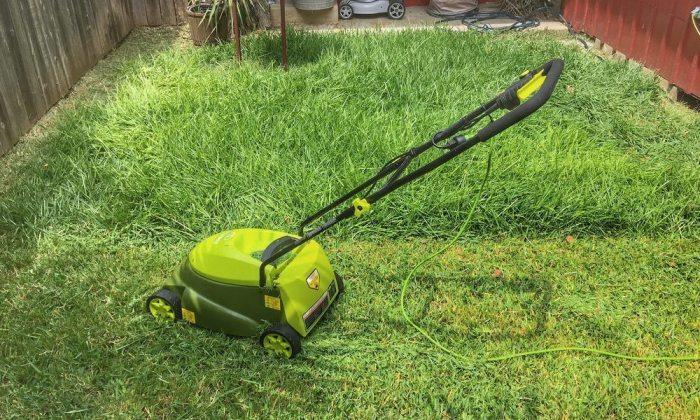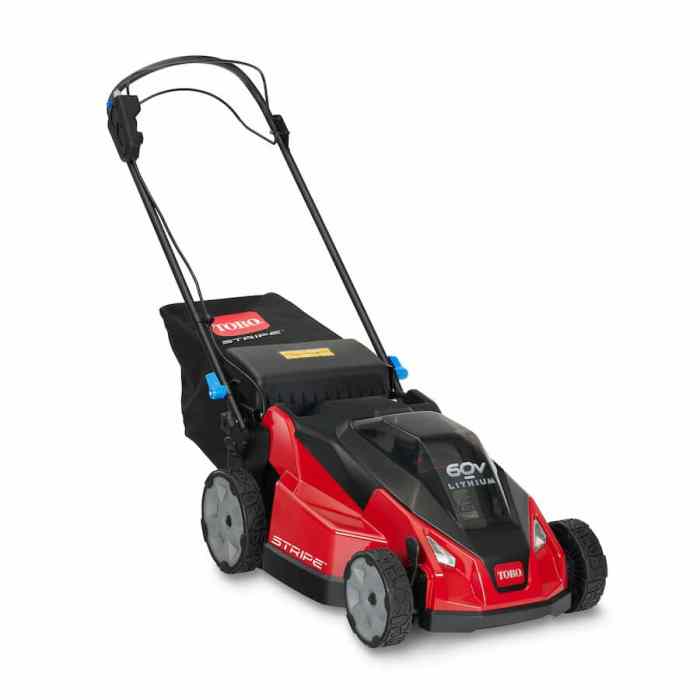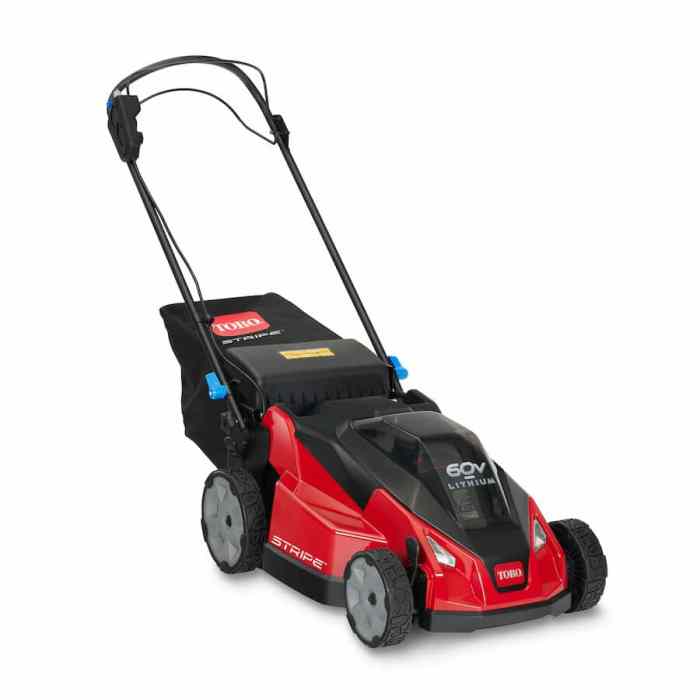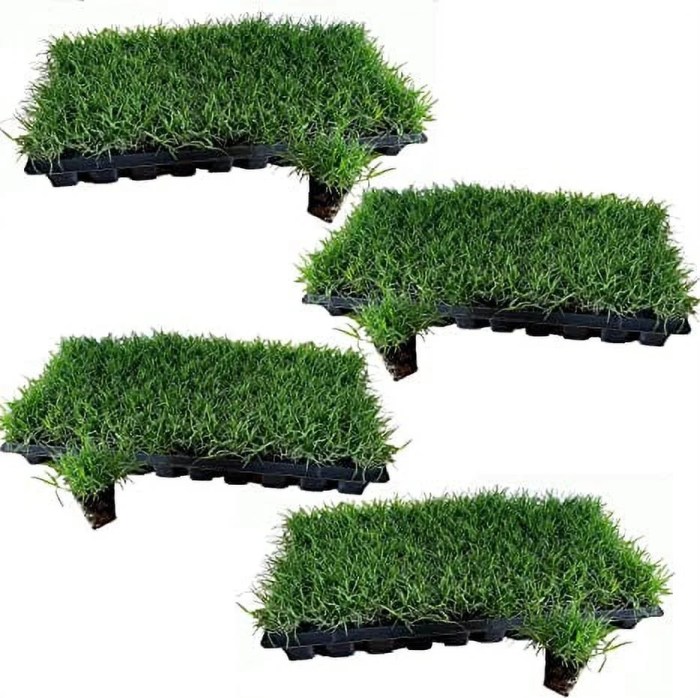How to choose a new lawn mower? This comprehensive guide walks you through selecting the perfect mower for your lawn, budget, and lifestyle. We’ll cover different mower types, from push mowers to riding mowers and robotic options, exploring their pros and cons, suitability for various terrains, and the importance of a realistic budget. Fuel efficiency and maintenance considerations are also discussed, providing a complete picture of your investment.
From assessing your lawn’s size and terrain to understanding the features and price range of different mowers, this guide will help you navigate the world of lawnmowers and make an informed decision. We’ll delve into essential factors like cutting height adjustment, mulching functions, and engine types, giving you a clearer perspective on how these aspects affect the mower’s overall cost and performance.
This is your one-stop resource for selecting the ideal machine for your needs.
Introduction to Lawn Mowers
Choosing the right lawn mower is crucial for maintaining a healthy and aesthetically pleasing lawn. Different types of mowers cater to various needs and preferences, ranging from small, manageable yards to expansive properties. Understanding the different types and their respective advantages and disadvantages is key to making an informed decision. The size of your lawn, the terrain, and your budget are all factors that will influence your choice.Selecting the appropriate mower depends on several key factors.
Lawn size, the type of terrain (flat, hilly, or uneven), and your budget are all important considerations. A small push mower might suffice for a tiny patch of grass, but a larger riding mower could be necessary for a sprawling lawn. The type of terrain will affect the maneuverability and power requirements of the mower. Budget plays a significant role in determining the features and capabilities of the mower.
Types of Lawn Mowers
Lawn mowers come in various forms, each with its own set of characteristics. The three most common types are push mowers, riding mowers, and robotic mowers.
Push Mowers
Push mowers are a traditional choice, ideal for smaller lawns. They are typically self-propelled, though some require manual pushing. Their simplicity and low cost make them appealing, and they are often suitable for flat or gently sloping lawns.
Riding Mowers
Riding mowers are powered machines that offer convenience for larger lawns. They provide a more comfortable and efficient way to cut grass on expansive properties, and various models cater to different needs, from basic models to those equipped with mulching or bagging capabilities. They are best suited for flat or gently undulating terrain.
Robotic Mowers
Robotic mowers are automated machines that cut grass autonomously. They are programmed to follow a pre-defined path, ensuring a precise and consistent cut. They are suitable for lawns with specific shapes and sizes, and are often a convenient choice for owners with little time to maintain their lawn.
Comparison of Lawn Mower Types
| Mower Type | Pros | Cons | Suitable for |
|---|---|---|---|
| Push Mower | Affordable, easy to maneuver in small spaces, good for smaller lawns, minimal maintenance | Labor intensive, not suitable for large lawns, not ideal for hilly or uneven terrain | Small lawns, flat or gently sloping terrain, budget-conscious individuals |
| Riding Mower | Efficient for large lawns, comfortable to use for extended periods, various features like mulching and bagging | Higher purchase price, requires more space for storage, potentially louder than push mowers | Large lawns, flat or gently undulating terrain, individuals seeking convenience |
| Robotic Mower | Automated cutting, low maintenance, precise cutting, minimal effort | Higher initial cost, requires a specific type of lawn, may not be suitable for very large or heavily overgrown lawns | Lawns with specific shapes, small to medium sized, those seeking minimal effort in lawn maintenance |
Lawn Size and Terrain Assessment
Choosing the right mower depends significantly on the size and terrain of your lawn. A poorly matched mower can lead to frustration and potentially damage your grass. Careful consideration of these factors will guide you towards a more effective and enjoyable mowing experience.Understanding your lawn’s dimensions and terrain is crucial for selecting the appropriate mower. This involves more than just eyeballing the space; precise measurements are vital to determine the right power and maneuverability.
Analyzing the contours of your yard will help you decide which mower type will best handle the unique challenges of your landscape.
Measuring Lawn Dimensions
Accurate measurement of your lawn is paramount. This involves determining both the length and width of the area you need to mow. Using a measuring tape or a measuring wheel will provide the most precise results. Consider the length of your longest side, and the widest portion of your lawn. Write down these measurements.
These figures will be crucial in comparing the features of different mowers. For irregularly shaped lawns, divide the area into manageable sections and measure each one individually, then add up the total area.
Assessing Terrain Types
Lawns aren’t uniformly flat; they present varying degrees of slope and unevenness. Recognizing these differences is essential in selecting a suitable mower.
- Flat Terrain: A flat lawn presents the simplest mowing challenge. The mower’s movement is consistent, and the machine is less likely to encounter obstacles.
- Sloped Terrain: Sloped lawns require a mower designed to maintain stability and prevent slippage. This type of terrain demands a mower with a low center of gravity and excellent traction. Steep inclines may necessitate a specific type of mower, or even alternative methods of mowing, such as hand mowing or hiring professional services.
- Uneven Terrain: Uneven lawns present obstacles such as bumps, rocks, or dips. A mower with excellent maneuverability and the ability to adapt to these irregularities is essential. These mowers often feature more robust suspension systems and improved turning radius.
Impact of Terrain on Mower Selection
The terrain of your lawn significantly influences the type of mower you should choose. A mower suited for flat terrain might struggle on a steep slope, potentially leading to operator fatigue and damage to the machine. Likewise, a mower designed for uneven terrain might not be efficient on a consistently flat surface. The specific features of your lawn, such as slopes, bumps, or dense vegetation, must be carefully considered.
A mower that’s well-suited to your terrain will enhance your mowing experience and preserve your mower’s lifespan.
Choosing a new lawnmower can be tricky, but knowing your yard’s dimensions is key. For example, if you’re unsure about the exact size of your lawn, a helpful tool like Google’s augmented reality measure app, ARCore Tango, google augmented reality measure app arcore tango update can help you get precise measurements. This way, you can select a mower that’s the right size and power for your space, preventing unnecessary hassle later on.
Mower Suitability for Various Terrain Conditions
| Terrain Type | Suitable Mower Types | Considerations |
|---|---|---|
| Flat | Push mowers, self-propelled mowers, robotic mowers | Ease of maneuverability and power output are key factors. |
| Sloped | Self-propelled mowers with good stability and traction, zero-turn mowers (for steep slopes). | Stability, traction, and the ability to maintain control are paramount. Consider the slope angle and length. |
| Uneven | Self-propelled mowers with good maneuverability and suspension, or zero-turn mowers. | Maneuverability and the ability to adapt to obstacles are essential. |
Budget and Features
Choosing the right lawn mower involves more than just considering size and terrain. A crucial factor is your budget and the features you prioritize. Different features directly impact the price, so understanding this relationship is essential for making an informed decision. Knowing the price range for various features helps you determine what you can afford and what features are worth the extra investment.Understanding your budget early on is paramount.
This prevents you from being overwhelmed by options that exceed your financial limits. Setting a realistic budget allows you to focus on mowers that fit within your price range, enabling you to make a well-considered purchase. This pre-emptive step helps avoid buyer’s remorse later.
Price Ranges for Lawn Mowers
Lawn mower prices vary significantly, depending on the features and engine type. Entry-level models, typically using gas-powered engines, start around $200. These mowers often have basic features like adjustable cutting heights, but may lack advanced features like mulching. Mid-range models, generally from $300 to $700, offer more features, including mulching or bagging options, and more powerful engines.
Higher-end models, priced from $700 and up, often include advanced technologies such as self-propulsion, electric motors, or robotic mowing capabilities. These are ideal for large lawns or complex terrains.
Importance of Setting a Budget
Setting a budget is crucial for avoiding unnecessary expenses. A clear budget helps you stay within your financial limits, preventing you from being swayed by unnecessary features. This approach ensures you are making a rational purchase, one that aligns with your financial capacity.
Features Influencing Mower Price
Several features significantly impact a lawn mower’s price. These include cutting height adjustment, mulching functions, engine types, and self-propulsion. The more advanced the features, the higher the price typically tends to be.
Comparison of Mower Features and Prices
| Feature | Description | Price Range |
|---|---|---|
| Cutting Height Adjustment | Allows you to customize the height of the cut, from a low cut for shorter grass to a higher cut for longer grass. This customization is crucial for maintaining a healthy lawn. | Generally, models with a wider range of cutting height adjustments are slightly more expensive than those with a fixed height. The difference isn’t dramatic, but it’s worth considering. Expect this feature to be available on nearly all models. |
| Mulching Function | Chops grass clippings into small pieces, which are then returned to the lawn as fertilizer. This feature saves time and effort compared to bagging or disposing of clippings. | Models with mulching functions often fall in the mid-range price segment, usually between $300 and $700. Budget-friendly models might not include mulching, while high-end models often have this feature. |
| Engine Type | Gas-powered engines are common in entry-level and mid-range mowers, offering good power and affordability. Electric mowers are becoming more popular, offering quiet operation and zero emissions, but come with a higher price tag. | Gas-powered mowers generally fall into the lower and mid-range price categories, with electric models often in the higher range. The cost difference between these engine types can be substantial. |
Fuel Efficiency and Maintenance

Choosing the right lawn mower involves more than just aesthetics and power. Understanding fuel efficiency and maintenance requirements is crucial for long-term cost savings and a smooth mowing experience. Different mower types have varying needs, so careful consideration of these factors will help you make an informed decision.
Fuel Efficiency of Different Mower Types
Gas-powered mowers, whether riding or push, generally offer more power and larger cutting areas but come with a trade-off in fuel efficiency. Electric mowers, on the other hand, are significantly more fuel-efficient, operating entirely on electricity and eliminating the need for gas refills. Electric push mowers, while less powerful than gas-powered counterparts, are excellent for smaller lawns and are remarkably quiet.
Electric riding mowers offer a balance between power and fuel efficiency, ideal for medium-sized lawns.
Importance of Regular Maintenance
Regular maintenance is paramount for maximizing the lifespan and performance of any lawn mower. It not only ensures smooth operation but also helps prevent costly repairs down the line. By following a consistent maintenance schedule, you can significantly extend the life of your mower and avoid unexpected breakdowns during crucial mowing seasons. Preventive maintenance is often more cost-effective than addressing problems after they arise.
Maintenance Tasks for Different Mower Types
Gas-powered mowers require more frequent maintenance compared to electric mowers. Regular checks of the fuel system, spark plugs, and air filters are essential. Electric mowers primarily need battery checks, blade maintenance, and occasional cleaning of the motor housing. Riding mowers demand more attention to components like the transmission, hydraulics (if applicable), and tires.
Essential Maintenance Tools
A well-stocked toolkit is crucial for effective maintenance. Essential tools include a wrench set (various sizes), a screwdriver set, a socket set, a wire brush, a cleaning brush, a lubricant (like engine oil), and safety glasses. Investing in a quality toolkit will make maintenance tasks much easier and safer.
Estimated Maintenance Costs
| Mower Type | Fuel Efficiency | Estimated Maintenance Costs (Yearly) |
|---|---|---|
| Gas-powered Riding Mower | Lower (variable depending on usage and fuel prices) | $100-$300 (includes fuel, oil, and basic repairs) |
| Electric Push Mower | High | $50-$100 (primarily for blade sharpening and battery maintenance) |
| Electric Riding Mower | Medium | $75-$200 (includes battery maintenance, blade sharpening, and occasional motor cleaning) |
Note: Estimated maintenance costs are approximations and can vary based on usage, type of grass, and the specific mower model. Professional servicing can also impact the costs.
User Reviews and Expert Opinions
Deciding on a new lawnmower can feel overwhelming with so many options available. Fortunately, user reviews and expert opinions can provide valuable insights, helping you make an informed choice. They offer firsthand accounts and professional evaluations, both crucial for narrowing down your options.User feedback and expert analysis offer a more comprehensive understanding of a product’s strengths and weaknesses, which is often missing in the manufacturer’s marketing materials.
Choosing a new lawnmower can be tricky, but consider the size of your yard and the type of grass. You’ll also want to think about features like mulching capabilities, and if you need extra power for tough conditions. Knowing how to choose the right one for your needs is key, but understanding technical concepts like a circuit level gateway can also be helpful.
A circuit-level gateway, for example, acts as a critical connection point in network communication, much like a powerful lawnmower can efficiently cut through tough grass. Ultimately, the best choice depends on your budget and needs. Finding the perfect lawnmower is important to keeping your lawn looking its best, so carefully weigh your options before you buy! what is a circuit level gateway
This helps you avoid potentially problematic choices and make a decision that better aligns with your needs and preferences.
Importance of Reading User Reviews
User reviews provide firsthand experiences, helping you understand how a particular mower performs in various situations. They can reveal critical details like maneuverability on different terrains, cutting performance on various grass types, and the overall durability of the machine. Reading through a variety of reviews gives you a holistic view, highlighting both the positive and negative aspects. This diverse perspective allows you to assess the mower’s suitability for your specific lawn and usage patterns.
Reputable Sources for Expert Opinions
Numerous reputable sources offer expert opinions on lawnmowers. Consumer Reports, a well-known consumer advocacy organization, provides detailed reviews and ratings based on rigorous testing. Gardening magazines and websites often feature articles by experienced landscapers and gardening professionals. Online forums dedicated to lawn care and gardening equipment also frequently feature expert discussions and recommendations. By considering expert opinions from these reliable sources, you can gauge the product’s overall quality and performance.
Evaluating the Credibility of Online Reviews
Assessing the credibility of online reviews is crucial. Look for reviews from users with verifiable experience, such as those who mention specific details about their lawn or mowing habits. Beware of overly positive or negative reviews that seem too good or too bad to be true. Check for patterns in the reviews; consistent complaints about a particular feature may indicate a genuine problem.
Be mindful of potential biases, such as reviews from competitors or individuals with vested interests. Also, consider the overall number of reviews; a small number of reviews may not provide a comprehensive representation of the product’s performance.
Review Platforms
Several platforms offer lawnmower reviews. Amazon is a common source for user reviews, often including a wide range of opinions from different users. Sites like Consumer Reports, Wirecutter, and other similar publications provide in-depth reviews based on expert analysis. Specialized gardening forums and online communities offer a unique perspective, providing insights from experienced users. These platforms can be valuable resources for gathering diverse opinions.
Comparison of Ratings from Different Sources
| Review Source | Rating for Push Mower X | Rating for Riding Mower Y |
|---|---|---|
| Amazon | 4.5 out of 5 stars | 4.2 out of 5 stars |
| Consumer Reports | 4 out of 5 stars | 4.1 out of 5 stars |
| Wirecutter | 4.3 out of 5 stars | 4.0 out of 5 stars |
This table presents a simplified comparison of ratings. Real-world ratings often depend on specific criteria and testing procedures used by each review source. Consider the criteria each source emphasizes to better understand the context behind the ratings.
Choosing a new lawn mower can be tricky, but thinking about the features you need is key. Consider the size of your yard and the type of grass you have. For outdoor adventures, a rugged smartwatch like the Garmin Instinct, with its various pricing options and features, is a must-have. Checking out Garmin Instinct rugged smartwatch outdoors pricing features will help you decide if it fits your needs.
Ultimately, the right mower comes down to your specific needs and budget, so do your research!
Additional Considerations
Choosing the right lawn mower involves more than just size and budget. Factors like warranty, noise levels, and maneuverability play crucial roles in the overall user experience and long-term satisfaction. Understanding these aspects will help you make a more informed decision, ensuring your new mower is a worthwhile investment.Careful consideration of these additional elements can significantly impact your mowing experience.
From the peace of mind a strong warranty provides to the comfort of quiet operation and the ease of navigating your yard, these factors influence your overall satisfaction with the mower.
Warranty
Warranty details are essential to consider. A robust warranty offers peace of mind, ensuring the mower is covered for repairs or replacements during the initial period. It demonstrates the manufacturer’s confidence in their product and provides a safety net for potential issues.
- Different warranties vary considerably in their coverage. Some warranties cover parts and labor for a set number of years, while others might focus on specific components. Thoroughly review the warranty details before committing to a purchase. It’s essential to compare the terms of different brands and models.
- Example: A five-year warranty on the engine and five years on the deck, but only one year for the drive system, would differ significantly from a three-year warranty covering all parts and labor.
- Warranty coverage should include repairs for malfunctions or defects in materials and workmanship. Look for exclusions and limitations that could affect the warranty’s effectiveness. Knowing these specifics will save you from potential disputes later.
Noise Levels
Noise levels are a frequently overlooked but important aspect. Loud mowers can be disruptive to neighbors and potentially cause stress. Modern technology offers quiet operation, and quieter models are worth considering for a better overall experience.
- Consider the proximity of your neighbors and your personal preference for noise levels. If you live in a densely populated area or have neighbors nearby, a quieter mower is crucial for maintaining good relationships.
- Manufacturers often provide decibel ratings for their mowers. Compare these ratings when selecting different models.
- Electric mowers are often significantly quieter than gas-powered ones. The absence of an engine exhaust system contributes to their lower noise output.
Maneuverability
Maneuverability greatly impacts how easy and efficient the mowing process is. Different designs and features affect how well the mower handles in tight spaces and around obstacles.
- Consider your lawn’s layout and the presence of trees, flowerbeds, or other obstacles. A mower with good maneuverability will save time and effort, allowing you to efficiently cover your entire lawn.
- Some mowers offer front-wheel or rear-wheel drive, impacting turning radius and overall control. Front-wheel drive often provides better agility, especially in tight spaces, while rear-wheel drive might offer better stability on uneven terrain.
- Consider the width of the mower and how it will navigate corners and tight areas of your lawn. A narrow mower might be more maneuverable but may take longer to complete the mowing task.
Choosing the Right Mower for You: How To Choose A New Lawn Mower
Deciding on the perfect lawn mower involves careful consideration of various factors. Your specific needs, from the size of your yard to your budget, play a crucial role in determining the ideal machine. This section provides a structured approach to help you make an informed choice.
Factors to Consider When Choosing a Lawn Mower, How to choose a new lawn mower
This section summarizes key factors for making the best lawnmower purchase decision. Understanding these factors is critical to ensuring the mower meets your long-term needs and lawn maintenance goals. The table below highlights these factors and their importance.
| Factor | Importance | Example |
|---|---|---|
| Lawn Size | Crucial in determining the required cutting capacity and maneuverability. A larger lawn necessitates a mower with a larger cutting deck and potentially more powerful engine. | A small, 5,000 sq ft lawn might be well-suited to a self-propelled push mower or a lightweight riding mower, while a larger, 15,000 sq ft lawn would benefit from a more robust riding mower or a zero-turn mower. |
| Budget | A key constraint influencing the type and features of the mower. Budget limitations can guide the selection towards less expensive models or the purchase of used equipment. | A budget of $500-$1000 might limit the selection to mid-range models or used riding mowers, while a budget exceeding $2000 opens the door to more advanced features like electric models, or zero-turn riding mowers. |
| Terrain | Significant in determining the mower’s suitability. Steep slopes or uneven terrain necessitate mowers with enhanced traction and maneuverability. | A lawn with significant slopes or uneven terrain will likely require a riding mower with four-wheel drive or a zero-turn mower for stability and control, while a flat, level lawn can be managed by a variety of mowers. |
| Cutting Preferences | Different mowers offer various cutting heights and mulching options. Consider your desired cut and if you want to mulch or bag clippings. | Some users prefer a neat, short cut, while others may prefer a slightly longer, more natural look. Mulching or bagging clippings influences the type of mower needed. |
| Maintenance Requirements | Gas mowers require more frequent maintenance, such as oil changes and fuel system upkeep, while electric mowers typically require less upkeep. | The maintenance commitment influences the type of mower chosen. The need for less maintenance might sway a user towards an electric mower. |
Matching Mower Type to Your Needs
Choosing the right mower type is vital for effective and efficient lawn care. Different mower types cater to varying lawn sizes, terrain conditions, and personal preferences.
- Push Mowers: Ideal for small, flat lawns, push mowers are typically affordable and easy to maneuver. They are best for small properties and are a good option for beginners or those on a budget. They are also very portable and can be stored easily.
- Riding Mowers: These mowers are best for larger lawns and offer greater convenience and comfort, especially when dealing with hilly terrain or larger properties. The increased comfort comes at a higher cost.
- Zero-Turn Mowers: Designed for quick and precise maneuvering on various terrains, zero-turn mowers excel on lawns with slopes, obstacles, or uneven surfaces. The price tag reflects the advanced maneuverability.
- Robotic Mowers: Perfect for lawns with specific shapes or features, robotic mowers require minimal human intervention and can provide a precise cut. The price often reflects the convenience and efficiency.
Making the Final Decision
After considering the factors above, carefully evaluate your specific needs. Thoroughly research different models within your preferred category. Consider reviews and expert opinions, as well as the warranty offered. Ultimately, the best mower is the one that meets your needs and budget effectively.
End of Discussion

Choosing the right lawn mower is crucial for maintaining a healthy and beautiful lawn. This guide has provided a thorough overview of the factors to consider, empowering you to make an informed decision. From evaluating your lawn’s characteristics to understanding the different mower types, features, and maintenance requirements, you’re now equipped to find the perfect machine for your needs.
Remember to prioritize your budget, terrain, and lifestyle preferences when making your final selection. Happy mowing!










